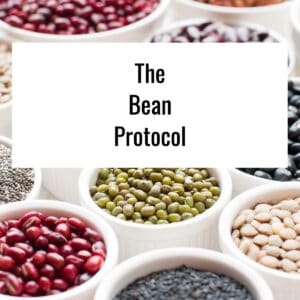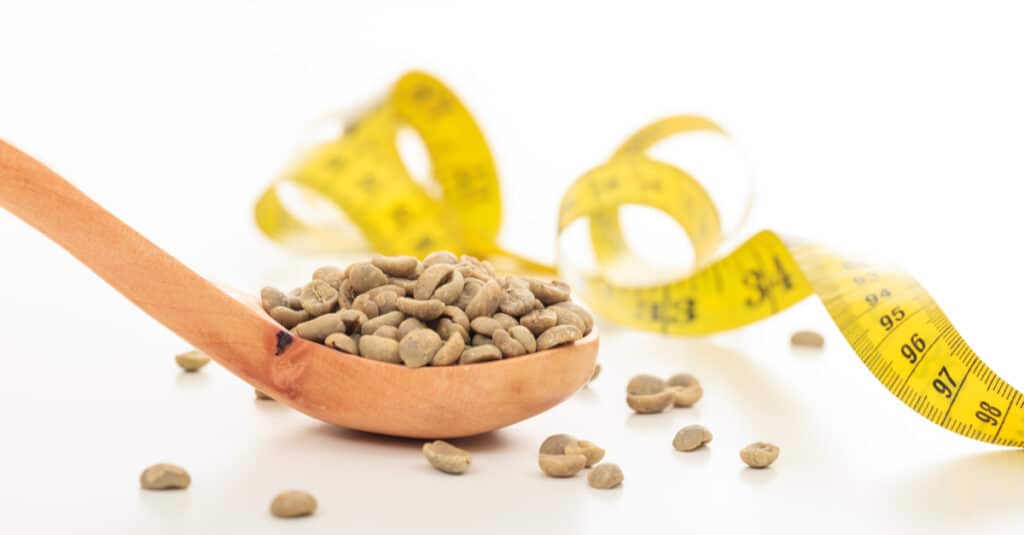The Bean Protocol Review - 13 Things You Need to Know
Karen Hurd started everything on a mission to save her child’s life. From there, it grew into the Bean Protocol – a kinda plant-based diet that aims to improve health in the entire population.
We’re here to look deep into the program and see if there’s any research to support the big claims Hurd makes. Check out our bottom line on this bean-based eating program.
The Bean Protocol can be purchased through their Official Site.
What is the Bean Protocol?
The Bean Protocol Diet is a plant-based dietary regimen that aims to add lots of soluble fiber to the individual’s diet. The stated goal is to aid in liver detox. The liver depends on soluble fibers to remove toxins from the body. These toxins, chemicals, and hormones bind to detergent-like bile. The soluble fiber and bile are then excreted naturally by the body.
In the Protocol, the user stops consuming alcohol, sugar, caffeine, and other non-essential foods. At each meal (three to six small meals per day, depending on your needs), you eat beans, vegetables, and proteins. In between meals, you may eat up to one cup of nuts and three quarts of room temperature water throughout the day (no chilled water). Research studies say:
- PLoS One – Beans contain high levels of soluble fiber that, according to researchers, promotes the growth of gut-friendly bacteria.
- Comprehensive Reviews in Food Science and Food Safety – Fava beans are a “rich source of proteins, fiber, and other non-nutrient compounds considered beneficial for health.” Though, people in the US haven’t “fully exploited” this protein source.
- American Journal of Health Behavior – “There are knowledge gaps about the health benefits of bean consumption. Nutrition education to improve knowledge may lead to increased bean consumption, reducing health disparities and improving nutrition.”
The Bean Protocol Competitors
| Product | Review | |
|---|---|---|
| 3-Day Refresh | read | |
| DB Method | read | |
| Dr. Kellyann | read | |
| Noom | read |
Who Started the Bean Protocol Meal Plan?
Karen Hurd, formerly a military biochemist, started the Bean Protocol. In 1989, Hurd’s baby daughter suffered pesticide poisoning.
The baby’s symptoms including, infections, allergic responses, and more alarmed Ms. Hurd. Pediatricians and specialists couldn’t explain what was happening to her baby. Ultimately, she was told nothing could be done for her baby.
In response to the dire diagnosis, Karen Hurd researched the human body at a local med school library. She created a formula for her daughter that included soluble fiber, vitamins, and more. She fed the baby using a syringe. Her baby showed improvements in two weeks. By the sixth week, Karen Hurd announced that her baby was healthy again.
Scroll below for one of the best products we’ve seen over the last year.
Bean Protocol Claims
As more people jump on the Protocol bandwagon, claims that it helps skin conditions, fertility, and mental health conditions have appeared. Other claims of benefits when following the Protocol include glowing skin, great sleep, improved menstrual cycle, mood enhancer, promotes one’s natural hair color (stops graying) and more.These claims are based on anecdotal user reports and aren’t supported by research.
Bean Protocol Rules
The Protocol focuses on increasing dietary soluble fiber as part of the detox process for a minimum period of three months. The Protocol rules include:
- Eat 1.5 to 3 cups of cooked beans per day, consumed in one-half cup portions, from three to six meals or more, without consuming additional dietary fat.
- Consume 1 to 1.5 cups of nuts daily.
- Remove stimulants from the diet, e.g. coffee, sugar, fruits.
- Perform gentle exercise only, e.g. walking (no cardio).
- Consume no caffeine, cinnamon, supplements, fatty meats (e.g. sausage or bacon), dairy, sugar, coconut oil, or soy.
- Drink three quarts of pure water at room temperature each day.
- Rest at least 56 hours per week.
- Use no fragrances, e.g. those found in cleaning products, perfumes, personal care items, or freshly-cut flowers.
The Bean Protocol Food List
Here is a sample Protocol food list for one day:
- Prepared or dried beans, at least 1.5 cups per day (eaten in 1/2 c. portions)
- Lean protein (no visible fat), eaten in palm-sized portions
- Pure water, 3 quarts per day, room temperature, best between meals
- Green vegetables, e.g. broccoli, cauliflower, Brussel sprouts, cabbage
- Onions or other varieties of alliums
- Nuts, 1 to 1.5 cups per day
Sample Bean Protocol Menu
The Bean Protocol meal plan is relatively simple because your food choices are limited.
Breakfast: one-half cup beans of your choice with snipped green onions; water-sauteed spinach leaves; 2 ounces of lean roast beef
After breakfast: large glass of pure, unchilled water
Mid-morning snack: one-half cup of raw mixed nuts
After snack: large glass of pure, unchilled water
Lunch: one-half cup beans with chopped onion and water-sauteed garlic; lean toasted chicken breast; raw salad greens
After lunch: large glass of pure, unchilled water
Afternoon walk: large glass of pure, unchilled water
Mid-afternoon snack: one-half cup of raw almonds
Before dinner: large glass of pure, unchilled water
Dinner: one-half cup beans with steamed Brussel sprouts; lean turkey breast
After dinner: large glass of pure, unchilled water
Before bed snack: one-half cup of raw cashews
How to Trick the Bean Protocol Plan
Prioritizing healthy foods like beans, nuts, and lean proteins is sensible to improve your health and lose weight. The Protocol’s dietary restrictions may seem harsh after some time. To retain the benefits of the program without eating processed foods common in the average American diet, here’s how to trick the Bean Protocol plan:
Research from the European Journal of Nutrition shows that sugars found in natural foods, e.g. fruits and grains, differ from refined sugars, e.g. table sugar. Add a banana, apple, orange, or piece of pineapple to your breakfast, lunch, dinner, or snack.
In addition, you can use whole bean pasta (made entirely from beans) or sample Bean Protocol recipes created by other health enthusiasts.
Does the Bean Protocol Promote Weight Loss?
Yes. The Protocol promotes plant foods and small amounts of lean animal protein. It avoids added fats, e.g. oils and butter. The majority of research focuses on plant-based foods and the impact they have on overall health. For instance:
The International Journal of Environmental Research and Public Health published a study claiming, “Vegetarians and vegans also showed more adherence to their diet when compared to individuals who follow a paleo, gluten-free, or weight-loss diet.”
Then there’s the fact that the US Dietary Guidelines “encourage all Americans to eat more plant foods, including dried beans, whole grains, fruits, vegetables, and nuts,” claims research in the journal Nutrients.
DMSO: Targets and Therapy explains it plainly by saying, “An observational study with more than 10,000 participants eating different diets, revealed that the participants who ate plant-based had a significantly lower intake of energy [calories], total fat and saturated fat, compared to those who did not eat a plant-based diet. Thus, it may be assumed that a transition to a plant-based diet will result in reductions in weight.”
It looks like the Bean Protocol is on the right path.
Potential Bean Protocol Meal Plan Side Effects
You’re unlikely to have any serious side effects from following the Protocol for three months or so. If you miss eating fresh fruit with your meals, consider adding it to your meals to satisfy your cravings.
The major issues would have to be gas and flatulence. Beans are a high-fiber food that’s not 100% digestible. As the gut breaks down the food, there are gaps filled with air that eventually make their way out as flatulence (passing gas).
Bean Protocol vs. Fuhrman Nutritarian Diet
Both eating plans are fairly restrictive when compared to the average American diet, according to the Journal of the Academy of Nutrition and Dietetics. The recommended minimum duration of the Protocol is three months.
The Protocol, designed by Karen Hurd, removes sugar (including fructose from fruit), dairy, gluten, caffeine, processed foods, fatty or factory-farmed meats from the diet. It advises the consumption of at least 1.5 cups of lentils or beans each day (up to three cups per day, depending on the person) plus lean meat, leafy greens, allium vegetables (e.g. leek, onion, garlic), and cruciferous veggies (cauliflower, broccoli, Brussel sprouts, cabbage, etc.). The plan advises the user to drink three quarts of pure water each day and allows up to one cup of salted nuts between meals to manage hunger.
The nutritarian diet of Dr. Joel Fuhrman is quite similar to the Protocol, according to the American Journal of Lifestyle Medicine. Dr. Fuhrman’s Nutritarian Diet recommends eating “G-BOMBS” nutritarian foods, e.g. greens, beans, onions, mushrooms, berries, and raw seeds and nuts. The plan allows the user to consume up to 10 percent of their weekly calories in animal foods, including meat, chicken, fish, eggs, dairy, etc. It’s recommended as a life-long eating plan.
In comparison:
- The Protocol and Nutritarian programs are similar.
- Both eating plans promote health and wellness. According to the Journal of Geriatric Cardiology, primary plant-based diets aid in the management of lifestyle diseases like diabetes Type 2 (DM2), obesity, heart problems, and more.
- Certain Protocol instructions are unclear. For instance, users aren’t supposed to eat cinnamon.
Pros and Cons
Pros:
- Bean Protocol reviews are plentiful.
- Weight loss is possible if calorie intake is controlled.
- Helps build better eating habits that support overall health.
- Beans tend to stave off hunger.
- Nearly everyone needs to increase fiber intake.
Cons:
- The meal plan is strict, with little room for personalization.
- Most research supports a plant-based diet for weight loss.
- Could cause painful gas in some people.
- Hunger could cause binging on “healthy” foods.
What Users Are Saying
“Great recipes for the bean diet! I have tried a few and have liked them all. Pictures in book do not show how they really look. The food looks better in real life.”
“I haven’t read her book but heard her on a podcast. She sounds like a brilliant scientist. I really appreciate her advice concerning Covid-19. I’m conflicted when I hear that her recipes are based on beans as the latest research is beans contain harmful lectins which appear to be harmful to the gut lining. It’s all very confusing.”
“The cookbook is formatted well and has lots of options. I was a client of Karen Hurd (she was so helpful!) and needed to eat beans 4 times a day. I bought this for ideas for variety. Unfortunately, a lot of these recipes call for milk or cheese – which, because of my specific dietary issues, I couldn’t eat – or canned soup or processed meats (neither of which I eat). That said, the recipes look great and it is worth a look.”
Bottom Line on the Bean Protocol Diet
The bottom line is mostly good news. Bean Protocol weight loss is probable if you stringently follow the rules. The Protocol may serve as an effective cleanse or first step in achieving permanent weight loss. Any overly restricted dietary program can be difficult to follow over the long term.
Maybe such a restrictive diet isn’t a good thing for everyone. We’ve been researching weight loss for more than a decade and the plan that sticks out is Noom. It’s not just that Noom offers a dedicated personal coach and support system or that tens of millions of people have used the program. It’s that the program just works – and well enough that the CDC recognizes it as a healthy lifestyle choice.
Don’t take our word for it, you can check it out with a free trial offer available to all Dietspotlight readers for a limited time.
Learn More About Noom »





